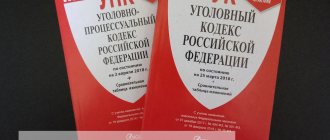Under what articles can a child be prosecuted if he killed?
Analyzing the content of Art. 20 of the Criminal Code of the Russian Federation, we can conclude that a minor who has reached the age of 14 will be liable under the following articles related to murder:
- Art. 105 – general as well as qualified murder.
- P. “b” part 3 art. 205 – a terrorist attack committed by a minor, during which the death of a person was intentionally caused.
- Art. 277 – an attack on the life of a statesman or public figure in connection with his activities or as revenge for his activities.
When they cannot attract due to age?
However, there are a number of crimes for which minors under 16 years of age cannot answer, even if these crimes involve intentionally causing death. These include:
- Art. 106 – Murder of a newborn child by a mother. Even if a girl under 16 gave birth to a child and killed him, she cannot be held criminally responsible here.
- Art. 107 – Murder in the heat of passion. Affect is a sudden and strong emotional disturbance when a person partially loses control over his actions. In cases where the passion is caused by the unlawful actions of the victim, the killer will receive a lighter punishment - and a minor under 16 years of age will not answer at all.
- Art. 108 – Murder involving excess of self-defense measures or measures necessary to apprehend a criminal.
- Art. 109 – Careless causing of death. Although formally this offense is not considered murder (according to the current criminal legislation of Russia, only intentional deprivation of life is considered murder), it is still: a minor under 14 years of age will not be held criminally liable for such an act. You can find out more about a detailed analysis of the concept of causing death by negligence here.
Procedure for applying punishment and types of liability
Administrative and criminal penalties may be applied to alimony defaulters. But the law establishes the procedure for their application:
- The claimant must submit a writ of execution, a court order or an agreement on the payment of alimony to the FSSP at the place of registration of the alimony holder.
- The bailiff initiates enforcement proceedings.
- The alimony provider has not paid child support for more than 2 months. The bailiff warns him about the application of administrative liability.
- The bailiff goes to court to impose administrative liability for non-payment of alimony. He can do this by his own decision or at the request of the recipient of alimony.
- The court makes a decision to hold the debtor accountable.
- The bailiff warns about the application of criminal liability. At the request of the recipient, the debtor is brought to criminal liability.
You cannot be punished for the same offense several times. Therefore, if the bailiffs have already drawn up a protocol under Art. 5.35.1 of the Code of Administrative Offenses of the Russian Federation, for the same offense one cannot be held criminally liable. You can also find out the amount by last name and gradually pay off the debt.
Key points related to the age of the offender
Criminal liability is closely related to the age of the perpetrator. Art. 20 of the Criminal Code of the Russian Federation provides for the following conditions:
- Full responsibility begins at age 16.
- From the age of 14, a person can be responsible for committing a number of crimes provided for in Part 2 of Art. 20 of the Criminal Code of the Russian Federation. These include murder (Article 105 of the Criminal Code of the Russian Federation).
- Some offenses require the person to be 18 years of age at the time of their commission. In particular, this applies to Art. 150 of the Criminal Code of the Russian Federation, which punishes the involvement of minors in criminal activities.
However, to bring to justice a person who is 14 years old but not yet 18 years old, special rules apply, provided for in Chapter 14 of the Criminal Code of the Russian Federation.
It states the following:
- A person who has reached 14 years of age but not 16 years of age may be sentenced to imprisonment.
- The sentence for juveniles has a lower upper limit than for adults. The lower limit for them is reduced by half.
How long are they imprisoned for tax evasion now? How can an accountant protect himself?
We have prepared a traditional review of criminal prosecution for tax and other business offenses at the end of 2022 and the beginning of 2022. As always, our goal is not to intimidate business leaders and chief accountants, but to give an objective picture of the real risks. But they exist.
When preparing the article, only official data from the Ministry of Internal Affairs, the Prosecutor General's Office, the Investigative Committee, the Federal Tax Service, Rosstat, and the Department of Judicial Proceedings of the Supreme Court of the Russian Federation were used.
While the government is discussing the regulatory guillotine, the real guillotine on tax crimes is working in full force, but one cannot help but admit that it has become more selective:
Thus, the continuing decrease in the number of on-site tax audits has also led to a decrease in identified tax crimes (materials for which are registered in the KUSP - a book for recording reports of crimes), and therefore in those investigated (for which criminal cases have been initiated).
You can learn everything about how to avoid getting into trouble due to tax audits in the Clerk online course - “Tax Audits. Defense tactics" . It is already available to users. Watch the story about this online course from its author Ivan Kuznetsov.
Until May 28, 15% discount using promo code KLERK15 (RUB 4,675 instead of RUB 5,500). Come in, register and learn!
It is not difficult to notice that there is still a whole abyss between the identified tax crime and the criminal case initiated, in which some audit materials are terminated by decisions to refuse to initiate a criminal case, some - after compensation for damage or after the expiration of the period for bringing to responsibility, some materials "football" “for months between districts or an operational unit and the investigation, and some... let's say, are terminated on grounds not provided for by the Code of Criminal Procedure of the Russian Federation.
Even fewer cases reach trial and verdicts: the Judicial Department will sum up the results of 2022 only by June, so the 273 verdicts on the graph are data for 6 months of 2022.
If the case goes to court, then according to the tax structure, you can actually go to prison; in 6 months of 2022, 25 people did this, and 3 people received more than 5 years in prison:
Let us remember that sanctions for tax crimes also provide for such severe sentences. For convenience, we have summarized the crimes in a general table:
It is interesting that tax crimes remain “male”, for example, out of 121 convicted under Part 2 of Art. 199 of the Criminal Code of the Russian Federation, only 17 women. Criminals most often (72%) are between 30 and 49 years old and very rarely younger - apparently they do not have time to become interesting to law enforcement officers. Our tax optimization seminars are also most often attended by people aged 30-49 years, but there are usually more women (mostly women are chief accountants, men are business owners or managers), so it turns out that women are more worried about their safety and, accordingly, become defendants less often. There is something for male business owners and managers to think about.
Despite the fact that men are more often convicted in tax cases, women also have many problems. The prospects for chief accountants due to the high-profile case of Galina Akhmadeeva are described in detail in our course “Tax Audits. Defense tactics."
Check out the program.
Almost every on-site tax audit is a potential criminal case initiated against the manager; the average amount of additional assessments of 22 million rubles is quite enough for Part 2 of Art. 199 of the Criminal Code of the Russian Federation:
On average, police officers are also interested in smaller amounts of arrears, since the damage to the budget from tax crimes is almost 95 billion rubles, which means one detected crime costs 12.9 million rubles. To put it very roughly, this is cashing out 25 million rubles over three years, or 694 thousand rubles per month. Since we have been practicing tax lawyers for more than 10 years, we can confidently say that every business, starting from small ones, is at risk.
But there is always the opportunity to “jump off” - in accordance with Art. 28.1 of the Code of Criminal Procedure of the Russian Federation - the court, as well as the investigator, terminates criminal prosecution against a person suspected or accused of committing tax crimes if, before the appointment of a court hearing, the damage caused to the budgetary system of the Russian Federation as a result of the crime is compensated in full (arrears, fines, penalties). Another thing is that the damage will need to be compensated in full and without dispute.
Why can’t the OBEP go away without a criminal case, and the tax authorities without additional charges?
For the first parts of tax articles, the criminal case is most often terminated altogether due to the expiration of the statute of limitations, because they are of minor gravity, and therefore on the basis of Art. 78 of the Code of Criminal Procedure of the Russian Federation, a person is exempt from criminal liability if two years have passed from the date of commission of the crime. In this case, the statute of limitations is calculated from the day the crime was committed (filing an inaccurate declaration) until the court verdict enters into legal force.
But this does not mean at all that in this case or in the event of termination of the criminal case on another non-rehabilitating basis (for example, an amnesty), the state will not have to compensate for the damage, and the well-known case of accountant Galina Akhmedova is proof of this.
As for the trends in 2022, already in January 2022 the Ministry of Internal Affairs reported an increase of 3.4% in economic crimes compared to January 2022. At the same time, grave and especially grave crimes in the total number of detected economic crimes amounted to 70.5%.
How is the online learning center Klerk.ru different from others?
The Kommersant newspaper published information in November 2022 that in order to strengthen the fight against tax evasion, the central office of the Investigative Committee of Russia (ICR) recommended its employees to identify and independently investigate related crimes, including those related to illegal banking activities. Previously, such investigations were transferred to the Ministry of Internal Affairs, but the Investigative Committee believes that tax crimes should be investigated in full with those that contribute to them.
The joint order of the Ministry of Internal Affairs of Russia N 317, the Federal Tax Service of Russia N ММВ-7-2/ [email protected] dated 05.29.2017 “On the procedure for submitting the results of operational investigative activities to the tax authority” and Letter of the Federal Tax Service and the Investigative Committee of the Russian Federation N ED-4-2 really works / [email protected] dated July 13, 2022, together with the “Methodological recommendations “On research and proof of facts of intentional non-payment or incomplete payment of tax (fee)” (in which tax officers are instructed to look for intent during on-site tax audits to improve the prospects of initiating a criminal case) .
But often the severity of the law continues to be compensated by its non-enforcement: in some Federal Tax Service Invoices they allow you to change invoices from one one-day invoice to another without additional tax payment; When identifying the use of “paper VAT”, tax authorities in most cases require a VAT adjustment without adjusting the income tax, and not all of the disputed counterparties are kicked out at once.
At the same time, this paradigm of tax optimization and business building carries a time bomb that entangles organizations with virtual inventory balances, debts to controversial counterparties, loans and bills, or numerous individual entrepreneurs separating flows with and without VAT, as well as denominations and an artificially complicated structure business.
Sign up for the first Clerk online course on inspections with a 15% discount. The course will teach you:
- competently and without unnecessary stress and labor costs to resist the pressure of tax authorities during audits;
- determine which actions of tax officials and police during inspections are illegal;
- correctly read the documents accompanying the inspections: the decision on the inspection, requirements for documents, the act, interrogation protocols;
- answer correctly during interrogations;
- understand all tax control activities: counter, interrogation, inventory, inspection, seizure;
- protect information from inspectors;
- correctly build a defense in the face of a criminal threat;
- understand what actions of an accountant will lead him to vicarious liability.
Hello Guest!
Enrollment is open for a unique advanced training course in management accounting three practicing teachers share their experience .
On the course you will find inspiration and new meanings in everyday work.
Sign up>>>
Differences in crime from adults
Text of Art. 105 of the Criminal Code of the Russian Federation, concerning murder, does not contain any indication that the elements of the crime in this case will differ depending on the age of the attacker. However, there are some nuances that must be taken into account when considering the case.
The composition of any crime consists of 4 elements. In relation to murder, they will look like this:
- The object is what the attack is aimed at. In this case, it is the life of another person.
- The objective side is the specific actions or inactions taken by the guilty person. In relation to murder, there will be no difference in this element for an adult or a juvenile offender.
- The subject is the person who committed the crime. As already mentioned, liability under Art. 105 of the Criminal Code of the Russian Federation begins at the age of 14. If we take this circumstance into account, there will not be any significant differences.
- The subjective side is the mental attitude of the perpetrator to the act he committed. This includes intent (in relation to murder - both direct and indirect, but unintentional causing of death is considered under another article), motive, etc.
Specifically, on the subjective side, there are certain differences between crimes committed by adults and teenagers. As a rule, minors are characterized by social and mental immaturity. That is why, when considering a case and imposing a punishment, it is necessary to determine as clearly as possible how much the teenager was aware of the illegality and social danger of his act, as well as what motives he was guided by.
Important! For a correct assessment of the subjective side of the act in cases where minors are accused, a psychological and psychiatric examination is almost mandatory.
More information about murder committed by adults and the punishment for it can be found here.
Criminal law rules regarding the murder of a child
Criminal law singles out a category of crime victims as a separate item only if either the victim needs special protection or justice requires special punishment.
In relation to cases where a minor becomes a victim of murder, there are two main provisions of the Criminal Code of the Russian Federation:
- P. “c” part 2 art. 105 of the Criminal Code of the Russian Federation is a general rule on murder, which, however, applies such a qualification as murder of a minor.
- Art. 106 of the Criminal Code of the Russian Federation - a situation where the victim is a newborn, and the killer is his mother shortly after birth.
However, the difference between these norms is too significant: clause “c” of Part 2 of Art. 105 concerns any cases where the victim is a young child, and Art. 106 – exceptionally narrow situations when a woman, being in a psychologically traumatic situation or having not yet fully recovered after childbirth, commits the murder of her child. It is precisely because of the excessive narrowness of further Art. 106 of the Criminal Code of the Russian Federation will not be discussed.
But regarding clause “c” of Part 2 of Art. 105 the following should be kept in mind:
- First of all, we must be guided by the general definition of murder. In practice, this means that the death must be caused intentionally. Carelessness, even if it resulted in death, is not considered murder in current criminal law (more information about the analysis of the concept of causing death by negligence can be found here).
- Murder of a minor is a charge included in Part 2 of the article on murder. This part provides for special variants of this crime, punishable more harshly than ordinary murder.
- Clause “c” part 2 includes responsibility for the murder of not only a minor, but also another helpless person, as well as a kidnapped person. The increased severity of punishment in this case is due to the fact that, from the point of view of public morality, the murder of a child, an old man or another person who cannot defend himself is a more terrible act than ordinary murder.
- Criminal legislation does not define the concept of “minor”, therefore, for the correct application of this article it is necessary to use the norms of other branches of law.
In particular, if we turn to the civil, then, according to Art. 28 of the Civil Code of the Russian Federation, we can conclude that a minor should be considered one who has not reached the age of 14 years. This analogy is also confirmed by the fact that 14 years is the minimum age of criminal responsibility according to Art. 87 of the Criminal Code of the Russian Federation. - Also, criminal law does not provide a clear definition for the helpless state of a person. The fact is that current law enforcement interprets this sign differently in relation to different crimes. In general, you can focus on clause 7 of the Resolution of the Plenum of the Armed Forces of the Russian Federation No. 1 of January 27, 1999. Having analyzed the practice of considering cases under Art. 105 of the Criminal Code of the Russian Federation, the Plenum identified as helpless persons who, due to age, illness or mental disorder, cannot correctly perceive what is happening to them and around them.
- Previously, law enforcement practice tended to classify sleepers and those in a state of intoxication (alcohol or drugs) as helpless persons. However, after 1999, when the above-mentioned resolution was adopted, the courts (including the Supreme Court) began to approach this issue differently, excluding sleep and intoxication from signs of helplessness in relation to murders. In relation to crimes related to sexual freedom or integrity, they are still used as signs of the helpless state of the victim.
Important: The qualifying feature in relation to clause “c” of Part 2 of Art. 105 of the Criminal Code of the Russian Federation is the helpless state of the victim.
However, can every minor be called helpless? In practice, this issue remains controversial, and in most cases, situations where the murdered person is under 14 years of age are considered precisely on this point.
You can find out more about the punishment for killing a person here.
How many years do you get for causing death under Art. 105 of the Criminal Code of the Russian Federation?
Art. 105 of the Criminal Code of the Russian Federation, which provides for liability for murder, consists of two parts:
- Ordinary murder - part 1.
- The same crime, but committed with additional qualifying characteristics (murder of two or more persons, with particular cruelty, etc.) – part 2.
Both parts provide for different penalties:
- Part 1 – from 6 to 15 years;
- Part 2 – from 8 to 20 or for life.
When assigning punishment to a minor, the provisions of Art. 88 of the Criminal Code of the Russian Federation. Part 6 of this article provides that for those who have committed a particularly serious crime, the maximum term cannot be higher than 10 years. This category of crimes, according to Part 5 of Art. 15 of the Criminal Code of the Russian Federation, include those where the maximum punishment exceeds 10 years. It is easy to notice that both parts of Art. 105 of the Criminal Code of the Russian Federation belong to this category. Thus, no matter what type of murder a minor commits, he cannot be sentenced to more than 10 years in prison.
As for the lower limit of punishment, clause 6.1 of Art. 88 of the Criminal Code of the Russian Federation. It states that for minors, the minimum sentences are reduced by half. Therefore, a teenager can be punished at a minimum:
- for committing murder under Part 1 of Art. 105 of the Criminal Code of the Russian Federation – for 3 years;
- for the same crime provided for in Part 2 of the same article - for 4 years.
How does the law differentiate types of murder?
A person can take someone’s life by accident, without malicious intent, and then the punishment for him will not be as cruel as if he intentionally causes death. In this regard, legislators have divided such crimes into several types, each of which provides for different terms and penalties. Chapter 16 of the Criminal Code of the Russian Federation talks about all crimes against human life and health.
The law divides all crimes into light, moderate, grave and especially grave. So, murder belongs to the latter type, since it involves the taking of life; but how much they give for it depends on many factors. Article 105 of the Criminal Code of the Russian Federation calls murder the intentional infliction of death of another person and states that such a crime is punishable by 6 to 15 years in prison. The article also adds restriction of freedom for up to 2 years (which can be added to the main punishment).
According to paragraphs 16 of Chapter 16 of the Criminal Code of the Russian Federation, all murders can be differentiated into:
- intentional deprivation of human life as such (murder and its subtypes);
- causing the death of a newborn by his own mother;
- deprivation of a person’s life in an inadequate state (in a state of passion);
- murder in self-defense;
- causing death by negligence.
Punishments for all these acts can be very different, because the investigation always takes into account the condition of a particular person. How much they pay for murder depends on many factors. An important role is played by the circumstances in which the act was committed, as well as the time, place and availability of the opportunity to avoid it.
How long can a child be imprisoned for an assassination attempt?
The Criminal Code of the Russian Federation provides for punishment not only for completed murder, but also for an attempt to commit it. In this case, the culprit will be punished under the same article. 105 of the Criminal Code of the Russian Federation, but with reference to Part 3 of Art. 30 of the Criminal Code of the Russian Federation, which defines the concept of attempt.
Art. 30 does not stipulate features related to the age of the offender, so a minor will be liable for attempted murder in the same way as an adult attacker.
However, it must be taken into account that an attempt has its own upper limit of punishment. It is provided for in Art. 66 of the Criminal Code of the Russian Federation. According to its norms, the maximum sentence for an attempt cannot be more than three quarters of that specified in the relevant article. However, it should be noted that for teenagers this norm is irrelevant: even under Part 1 of Art. 105 of the Criminal Code of the Russian Federation, three quarters of the maximum term is 11 years 3 months, which is already more than 10 years, provided for in Art. 88 of the Criminal Code of the Russian Federation.
More information about attempted murder can be found here.
How long can you be imprisoned for failure to pay child support?
As punishment for non-payment of alimony, not only fines, executive and compulsory labor are used. More serious penalties are also applied to defaulters:
- administrative arrest – from 10 to 15 days;
- arrest – up to 3 months;
- imprisonment – up to 1 year.
The procedure for applying punishment for non-payment of alimony is provided for by the following legal acts: Federal Law No. 323 of July 3, 2016 “On Amendments to the Criminal and Criminal Procedure Codes”; Art. 157 of the Criminal Code of the Russian Federation; Art. 5.35.1 Code of Administrative Offenses of the Russian Federation; Federal Law No. 229 of October 2, 2007 “On enforcement proceedings.”
Read the law
As you can see, the real term is the strictest measure of liability for non-payment of alimony, therefore it is applied in exceptional cases to particularly daring evaders. Typically, the courts are lenient towards alimony workers and limit themselves to correctional labor for a period of 6-8 months. Even when the debt amounts to hundreds of thousands of rubles. An example is the verdict of the Sovetsky District Court of Samara No. 1-200/2019 dated 06/06/2019, where a draft dodger with a debt of 677 thousand rubles was sentenced to correctional labor for a period of 6 months.
Have you ever experienced delays in child support payments?
Not really
Responsibility for threats
The threat of murder constitutes a separate crime under Art.
119 of the Criminal Code of the Russian Federation. According to it, the maximum penalty for Part 1 is up to 2 years, for Part 2 (if the crime was committed based on political, social, racial or other hatred) – up to 5 years.
If this crime is committed by a teenager, the consequences will be as follows:
- If he is under 16 years old , there will be no liability.
- If there are 16, but not 18 , he will answer, but the punishment will not involve imprisonment. He may be assigned compulsory or corrective labor under Art. 119 of the Criminal Code of the Russian Federation, but taking into account the rules of Parts 4 and 5 of Art. 88 of the Criminal Code of the Russian Federation.
Types of murder and punishments for them
Causing death by a mother to a newborn child. Such a crime is punishable by restriction of freedom for a term of 2 to 4 years, forced labor for up to 5 years and imprisonment for a term of up to 5 years. Despite the gravity of the crime, the state limits the term of punishment (Article 106 of the Criminal Code of the Russian Federation).
This is due to the possibility of depression, psychological postpartum trauma, and other mental disorders of the young mother. But if she took the life of her own child intentionally, fully aware of her act, her punishment increases.
Deprivation of life in a state of passion also applies to not particularly serious types of murder, but how many years are given for it depends on the circumstances and condition of the perpetrator. For such crimes, the court imposes punishment in the form of forced or correctional labor from 2 to 5 years, imprisonment for up to 5 years.
If a person killed his offender, who mocked him, insulted him, and forced him to commit illegal actions, this will be considered mitigating circumstances. In this case, the killer himself was a victim and took the life of another person in a state of passion. He could commit the same act against two or more people, and then he would be given a longer term of labor or prison (Article 107 of the Criminal Code of the Russian Federation).
If a person killed someone because he was defending himself and did not calculate his strength, the crime is classified as murder as a result of exceeding the limits of necessary self-defense. Despite the “unpremeditation” of the murder, the perpetrator faces correctional labor or imprisonment for up to 2 years (Article 108 of the Criminal Code of the Russian Federation).
Causing the death of a person who himself committed a crime and who needed to be detained is equated to the same type of crime. The perpetrator faces a similar punishment, only for up to 3 years. Such measures are due to the unplanned and “accidental” nature of the murder.
The lightest punishment for committing murder by negligence is forced labor, as well as restriction or imprisonment for up to 2 years. Causing death in such cases is usually associated with negligence in the performance of professional duties. Such a person is also prohibited from engaging in certain activities and working in leadership positions (Article 109 of the Criminal Code of the Russian Federation).
Causing death by negligence
Art. 105 of the Criminal Code of the Russian Federation provides for liability for causing death intentionally. However, in practice, there are cases when the perpetrator did not want to kill, but as a result of his actions the victim accidentally died. How will a minor respond in such a situation?
Liability for careless causing of death is provided for in Art. 109 of the Criminal Code of the Russian Federation. The maximum punishment under it is imprisonment for up to 2 years, and if a person did not fulfill his professional duties or accidentally killed two or more - up to 3 years.
However, Part 2 of Art. 20 of the Criminal Code of the Russian Federation in the list of articles for which responsibility begins at the age of 14 does not contain Art. 109. Consequently, the teenager will not be held liable for recklessly causing death.
It’s a different matter if death occurred as a result of grievous bodily harm caused intentionally, when the perpetrator simply wanted to cripple the victim, but she died unexpectedly. This crime is provided for in Part 4 of Art. 111 of the Criminal Code of the Russian Federation, and the perpetrator will be liable for it from the age of 14.
Corpus delicti
- The subject of the crime will be any sane person who has reached 14 years of age at the time of the murder (Part 2 of Article 20 of the Criminal Code of the Russian Federation).
- The subjective side of this crime is manifested only in intent.
The offender must either directly desire to cause the death of a minor (direct intent), or know about its possibility, but be indifferent to it (indirect intent). A feature of the subjective side, however, will be that the criminal knew for sure or could not help but know that the victim is a minor or is in a helpless state. - The object of the crime provided for in paragraph “c” of Part 2 is the same as under the rest of Art. 105 – human life. The essence of murder is that a person is deprived of life, death is caused to him. Therefore, in this case the encroachment will be on the life of a minor.
- The objective side of the crime in question consists of the actions that resulted in the death of the victim.
The last point deserves special attention. In any crime related to murder, it is necessary to identify the following features:
- Specific actions committed by the perpetrator (stabbing with a knife, shooting with a firearm, adding poison to food, etc., etc.).
- Consequences – namely the occurrence of death.
- Causal connection between the actions of the perpetrator and the occurrence of death. In some cases, death may occur due to natural causes, as a result of the actions of another person - in short, not because of anything the alleged killer did.
If at least one of these signs is missing, there is no need to talk about the presence of an objective side.
It must also be borne in mind that in relation to the murder of minors and helpless persons, the fact that murder can be committed not only by action, but also by inaction is more relevant than ever. In many cases, a young child or a helpless old man or patient cannot take care of themselves and ensure their livelihoods. In this case, the culprit simply needs to leave them - and death from thirst and hunger is possible.
Examples
Let's see what real cases look like in which the killers are minors.
First
17-year-old K. was drinking alcoholic beverages with a group of his friends. During the feast, he had a conflict with N., who was also present (K. was jealous of his girlfriend). The friends of both who were present there reassured K. and N., the conflict seemed settled.
However, when the company dispersed after the party, K. and N., together with another friend, returned the same way. A quarrel arose again, with the friend supporting N. Left in the minority, K. pulled out a folding knife and stabbed N. several times in the stomach. N. died on the spot from his wounds.
After K.’s identity was established, he wrote a confession and insisted that he was in a state of passion at that moment due to insults from the victim. However, the examination showed that he was completely sane and was not in a state of strong emotional disturbance at the time of the murder. As a result, K. was sentenced to 8 years in a correctional colony.
How to avoid going to jail for failure to pay child support
How to avoid punishment for non-payment of alimony? Yes, even malicious evaders sometimes manage to avoid responsibility. All they need for this is to periodically contribute small, insignificant amounts, give one-time gifts to their children, and make single purchases of things.
It is believed that this eliminates the repetition of a criminal offense and often serves as a basis for refusing to initiate a criminal case. In such cases, the FSSP recommends being guided by the legal position of the Constitutional Court of the Russian Federation, expressed in the Resolution of the Constitutional Court No. 13-P of July 30, 2001, according to which partial execution of a court decision does not ensure the protection of violated rights and does not exclude the criminality of the act. But there is no uniform practice, and investigators often refuse to initiate a case on this basis.









